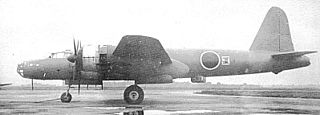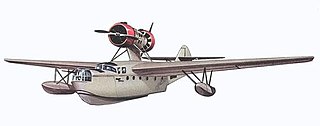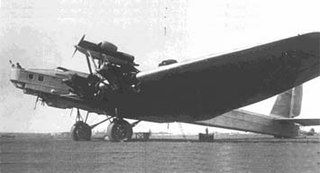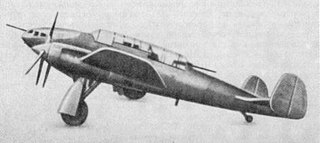The Douglas XB-31 was the design submitted by Douglas after the request by the United States Army Air Forces for a very heavy bomber aircraft, the same request that led to the Boeing B-29 Superfortress, Lockheed XB-30, and Consolidated B-32 Dominator.

The Nakajima G8N Renzan was a four-engine long-range bomber designed for use by the Imperial Japanese Navy. The Navy designation was "Type 18 experimental land-based attack aircraft" (十八試陸上攻撃機); the Allied code name was "Rita".

The Yermolayev Yer-2 was a long-range Soviet medium bomber used during World War II. It was developed from the Bartini Stal-7 prototype airliner before the war. It was used to bomb Berlin from airbases in Estonia after Operation Barbarossa began in 1941. Production was terminated in August 1941 to allow the factory to concentrate on building higher-priority Ilyushin Il-2 ground-attack aircraft, but was restarted at the end of 1943 with new, fuel-efficient, Charomskiy ACh-30B aircraft Diesel engines.

The Republic XP-72 was an American prototype interceptor fighter developed as a progression of the P-47 Thunderbolt design. The XP-72 was designed around the Pratt & Whitney R-4360 Wasp Major 28-cylinder air-cooled radial engine with a supercharger mounted behind the pilot and driven by an extension shaft from the engine. The armament consisted of six 50 caliber wing-mounted machine guns and underwing racks for two 1,000 lb bombs.

The Douglas A-33 was an American attack aircraft built in small numbers during World War II. It was an updated version of the Northrop A-17, with a more powerful engine and an increased bomb load. While the A-33 was intended initially for the export market, the entire production run was taken up by the United States Army Air Corps.

The Sukhoi Su-6 was a Soviet ground-attack aircraft developed during World War II. The mixed-power high-altitude interceptor Su-7 was based on the single-seat Su-6 prototype.
The Arado Ar 195 was a single-engine prototype carrier-based torpedo bomber, built by the German firm Arado for service on the German aircraft carrier Graf Zeppelin, during World War II.

The Savoia-Marchetti SM.62 was an Italian single-engine maritime patrol flying boat produced from 1926. It served with the Regia Aeronautica and with a number of foreign users, and was licence-produced in Spain and the Soviet Union. Some of the Spanish aircraft were still in service during the Spanish Civil War

The Chyetverikov MDR-6 was a 1930s Soviet Union reconnaissance flying-boat aircraft, and the only successful aircraft designed by the design bureau led by Igor Chyetverikov.

The Chyetverikov ARK-3 was a multi-role flying boat designed for Arctic operations that was built in the Soviet Union from 1933. It featured a conventional flying boat hull, with high cantilever wings equipped with floats at mid-span. The two piston engines were mounted in tractor-pusher fashion on a pylon above the fuselage.
The Tupolev MTB-1 was a patrol flying boat built in the Soviet Union in the mid-1930s. It was a refined version of the unsuccessful Chyetverikov MDR-3. The revised design retained the MDR-3's hull, but added a newly designed, full-cantilever wing, a new tail, and a new engine installation featuring two tractor and one pusher unit. Trials began in March 1934 but the prototype was destroyed during one takeoff.

The Tupolev ANT-16 was an experimental heavy bomber aircraft designed and tested in the Soviet Union in the early 1930s.
Tupolev TB-6 was a proposal by the Tupolev Design Bureau in the 1930s for a super-heavy bomber. Had it been built, it would have been the biggest-ever Soviet bomber and the largest aircraft by wingspan of its time, nine feet short of the 320 foot span of the Hughes H-4 Hercules, although the Scaled Composites Stratolaunch is now the biggest plane by wingspan.
The MDR-3 (a.k.a.11) was a long-range flying boat designed and built in the USSR from 1931.

The Polikarpov VIT-1 was a Soviet twin-engined multi-purpose aircraft developed before World War II. One prototype was built in 1937, with an extremely heavy armament for ground attack duties. That was the only example built as it was decided to revise the design with more powerful engines as the VIT-2.

The Polikarpov VIT-2 was a Soviet twin-engined ground attack aircraft developed before World War II. A single prototype was built in 1938 for evaluation purposes. Although a promising design it was recommended that it be introduced into production as a high-speed dive bomber with a reduced armament to increase its speed.
The Beriev MDR-5 (sometimes Beriev MS-5) was a Soviet long-range reconnaissance/bomber flying boat prototype developed by the Beriev design bureau at Taganrog. It did not enter production as the rival Chyetverikov MDR-6 was preferred.

The Voisin Triplanes were large experimental bombers built by Voisin in 1915 and 1916. After unsuccessful trials of the 1915 prototype a modified version with more powerful engines was built in 1916, as the Voisin E.28, but the type did not enter production.
The Zeppelin-Lindau C.II was a German single-engine two-seat biplane built by Zeppelin-Lindau during World War I.
The Mitsubishi G7M Taizan was a proposed twin-engine long-range bomber designed for use by the Imperial Japanese Navy in 1941.











